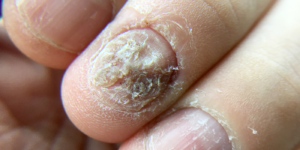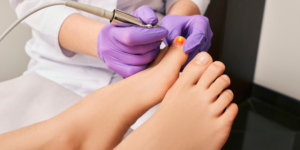Onychomycosis, fungal nail infections, impact millions globally. Fungal diseases including dermatophytes, yeasts, and molds invade nails, producing discomfort and cosmetic issues. This guide covers fungal nail infection causes, symptoms, and treatments to help you get healthy, beautiful nails.
Causes of Fungal Nail Infections
Fungal nail infections typically develop when fungi enter the nails through small cracks or separations in the nail plate. Several factors can contribute to the onset of these infections:
Damp Environments: Swimming pools, locker rooms, and community showers are major infection sites because fungi flourish in warm, damp settings.
Footwear: Tight-fitting shoes that don’t allow proper ventilation can create a suitable environment for fungal growth.
Nail Injuries: Fungi can enter nails through nail injuries.
Weakened Immune System: Diabetes and immunosuppressive medicines can weaken the immune system, increasing the risk of fungal infections.
Age: As people age, their nails become more susceptible to fungal infections due to reduced blood flow, slower nail growth, and a weakened immune system.

Symptoms of Fungal Nail Infections
The symptoms of fungal nail infections can vary in severity, and they typically start subtly, gradually worsening over time. Common signs of fungal nail infections include:
Discoloration: The affected nail may turn yellow, brown, or white. In some cases, the nail may become dark and discolored.
Thickening: Fungal infections can cause the nail to thicken and become brittle.
Brittleness: The nail may become crumbly, brittle, and easily prone to breakage.
Distorted Shape: As the infection progresses, the nail may lose its natural shape and become distorted.
Foul Odor: Some fungal nail infections emit a foul odor.
Pain: In severe cases, fungal infections can lead to pain and discomfort.
Treatment Options for Fungal Nail Infections
Since fungal nail infections are hard to treat, patience is key. Based on infection severity and conditions, the best treatment may differ. Best fungal nail infection treatments:
1. Over-the-counter (OTC) Antifungal Products
You can start by using OTC antifungal nail creams, ointments, or nail lacquers. These products contain active ingredients like miconazole, clotrimazole, or amorolfine that target fungi.
2. Prescription Medications
For more severe infections, a doctor may prescribe oral antifungal medications. These medications include terbinafine and itraconazole and are typically taken for several weeks or months. They work by targeting the infection from the inside, as opposed to topical treatments that work externally.

3. Topical Prescription Medications
In some cases, a healthcare provider may prescribe topical antifungal solutions or creams that are more potent than OTC options.
4. Laser Therapy
Laser therapy to heat the nail and kill the fungus is a newer treatment. This effective treatment may require numerous sessions.
5. Surgical Removal
For severe infections that don’t respond to other treatments, surgical removal of the infected nail may be necessary. After removal, a new, healthy nail should grow in its place.
6. Home Remedies
Some individuals opt for home remedies like vinegar soaks, tea tree oil, or coconut oil to manage mild cases of fungal nail infections. While these remedies may offer some relief, they are often not as effective as medically prescribed treatments.
7. Prevention Measures
Preventing fungal nail infections is as crucial as treating them. To prevent a recurrence or new infections, follow these preventative measures:
- Clean and dry your feet.
- Moisture-wicking socks and ventilated shoes
- Public spaces should be avoided while barefoot.
- Change socks and shoes often.
- Avoid shortening your nails by cutting them across.
- Keep nail clippers and files private.
- Shoes with antifungal powder or spray.
- Switch out contaminated shoes.
Conclusion
You can efficiently treat fungal nail infections and regain the healthy, attractive nails you previously had by utilizing over-the-counter or prescription drugs, considering laser therapy, or researching other treatment options. In addition, maintaining proper foot care and taking appropriate preventative actions can assist in lowering the probability of recurrence of infections.


